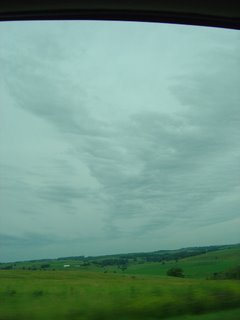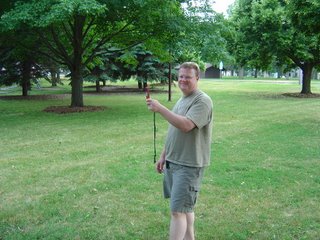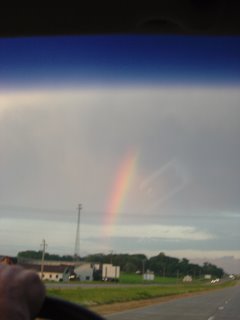June 20, 2006 Storm Chase: Chronicles of a Cap Bust
This appeared to be one of the better tornado setups in the upper Midwest since April. Scott Weberpal had invited me along again; and even though the last few model runs had thrown a few question marks into the mix, we were determined not to repeat the debacle of June 6th and it was all systems go Tuesday morning.
Scott arrived at my house about 8:15 in the morning and we headed to Verona where we met up with Chris Gullikson and transferred to his more spacious van for the long-distance trip.
From there it was a straight shoot westward to the target area in north-central Iowa. We passed through Barneveld, our second encounter with hallowed tornado ground in Wisconsin (the road to and from my house parallels the path of the Stoughton tornado). Close to the Platteville area we began to be overspread by the cirrus, then stratus clouds out ahead of the weakening complex of thunderstorms moving through eastern Iowa. The stratus clouds became quite photogenic as we neared, then crossed the Mississippi River at Dubuque.




Chris (left) and Scott (right) in Chris' chase van:

Approximately halfway between Dubuque and Waterloo, we encountered the rain associated with these thunderstorms. A few nice bolts of cloud-to-ground lightning flashed nearby, but I did not capture them since my video camera was still in its case. I was saving its tapes and battery power for the supercell-fest that appeared likely to unfold late in the afternoon into the evening. :-)
After a quick gas stop and lunch at Subway in overcast, rainy Evansdale, IA (a suburb of Waterloo) it was a non-stop drive to the initial target of Webster City in north-central Iowa, a little bit west of due north of Des Moines. We arrived there shortly before 2 PM and discovered a wifi hotspot next to a park, so we pulled over and Chris and Scott began pouring over every piece of available model, mesoanalysis, satellite and radar data while I observed intently over their shoulders.
The new mesoanalysis data and model runs were painting a confusing picture. The sky had cleared following the earlier round of showers and storms, but we were still in the cool sector well north of the warm front. The front had been expected to move north to near the Iowa/Minnesota border and serve as a focus for moisture pooling and thunderstorm initiation later in the afternoon. However, that front now appeared to have stalled over southwest Iowa, perhaps reenforced by outflow from the old storms. Meanwhile, the near-term RUC (Rapid Update Cycle) model wanted to veer the surface winds over most of Iowa to southwesterly by the evening, which would reduce surface convergence and hence the chances of new thunderstorm development. Also there was the little matter of the 10C H7 temperature line, which was analyzed by the mesoanalysis to be retreating westward, but the RUC insisted on planting it in eastern Iowa by 00z (7 PM). If correct, this meant warm temperatures at the mid-levels of the atmosphere that would also impede thunderstorm development.
As we mulled over these less-than-encouraging developments, we were joined by Doug Raflik and Todd Sprinkmann. We all clustered around the laptop computers, constantly refreshing the mesoanalysis and satellite loops, hoping something would jump out and provide a clue as to where to go from here. That was getting us nowhere, but luckily Doug and Todd had brought a foam-rubber football for amusement.
Scott drops back to pass:

Chris (left) and Doug (right):

Todd searches for a weakness in the defense:

We hung around the park for a good 3+ hours. In between catch sessions, we would run back to the vans to see if the analysis updates would make a target jump out at us, or if the Storm Prediction Center would issue a mesoscale discussion, or just something, ANYTHING that would provide a clue as to where the heck to go. Maybe we needed to get a better spiral on the football to induce some vorticity in the air. It gradually became more humid as the warm front neared, but it also clouded up again as isentropic lift on the warm front touched off weak, elevated showers and thunderstorms to its north-another potential wrench in the supercell machine.
Todd scans the atmosphere with his handheld anemometer/thermometer/hygrometer:

Scott and Todd compare dewpoint readings. Talk about your mesoscale boundaries!

After waiting around at the park for 3 1/2 hours, a ray of hope came at last at 5:20 PM in the form of a mesoscale discussion from the SPC, indicating that supercells and tornadoes were still possible across central and eastern Iowa. The md highlighted an area a bit east of where we were, and not wanting to be behind west-to-east moving storms we decided to head that way. Finally the chase was on...or was it? Chris turned the key in his van only to discover that the battery was dying and it wouldn't start! After taking about 10-15 minutes to jump start it from Doug's van, we said goodbye to Webster City.
We drove east the way we came, out of Webster City and toward Waterloo. The sky still did not look promising, with very little cumulus development. As the evening wore on it became apparent that the warm temperatures aloft were winning, so we just continued on home. Pushing into eastern Iowa, we encountered the only thunderstorm around, a small, lone cell that was making a valiant but ultimately futile attempt to overcome the cap. Like the morning storms, some light rain and a couple of lightning strikes were all it could muster. Then, as the setting sun to the west shone against the rain shafts of the storm, two spectacular rainbows appeared, one on either side of the highway.
These are of the one to the left (north) of the road. My pictures, taken from the backseat are not that great. Scott also got his camera out and I would expect his are better. I did not get still photos of the other rainbow to the south, although I did take video of it and might post a capture if I feel like it.


A picture of the sun dropping behind the clouds, made blurred by the long exposure time required by the low light as we move at 65 mph down the highway.

So much for long-distance chase #1. I didn't particularily expect to see tornadoes but I also did not expect a complete cap bust! However, I'd have felt worse sitting at home watching radar of supercells popping up all over Iowa, which given the conditions forecast by the earlier model runs was definitely within the realm of possibility. It was also fun to get out on the road and meet some of Wisconsin's veteran chasers. Chases like this seem to have been the rule for most of May and June 2006. Either the atmosphere finds some way to screw up a nice looking situation, or the situation looks so bad that nobody plans on chasing it, and it produces tornadoes (a la June 6 and 18).
Scott arrived at my house about 8:15 in the morning and we headed to Verona where we met up with Chris Gullikson and transferred to his more spacious van for the long-distance trip.
From there it was a straight shoot westward to the target area in north-central Iowa. We passed through Barneveld, our second encounter with hallowed tornado ground in Wisconsin (the road to and from my house parallels the path of the Stoughton tornado). Close to the Platteville area we began to be overspread by the cirrus, then stratus clouds out ahead of the weakening complex of thunderstorms moving through eastern Iowa. The stratus clouds became quite photogenic as we neared, then crossed the Mississippi River at Dubuque.




Chris (left) and Scott (right) in Chris' chase van:

Approximately halfway between Dubuque and Waterloo, we encountered the rain associated with these thunderstorms. A few nice bolts of cloud-to-ground lightning flashed nearby, but I did not capture them since my video camera was still in its case. I was saving its tapes and battery power for the supercell-fest that appeared likely to unfold late in the afternoon into the evening. :-)
After a quick gas stop and lunch at Subway in overcast, rainy Evansdale, IA (a suburb of Waterloo) it was a non-stop drive to the initial target of Webster City in north-central Iowa, a little bit west of due north of Des Moines. We arrived there shortly before 2 PM and discovered a wifi hotspot next to a park, so we pulled over and Chris and Scott began pouring over every piece of available model, mesoanalysis, satellite and radar data while I observed intently over their shoulders.
The new mesoanalysis data and model runs were painting a confusing picture. The sky had cleared following the earlier round of showers and storms, but we were still in the cool sector well north of the warm front. The front had been expected to move north to near the Iowa/Minnesota border and serve as a focus for moisture pooling and thunderstorm initiation later in the afternoon. However, that front now appeared to have stalled over southwest Iowa, perhaps reenforced by outflow from the old storms. Meanwhile, the near-term RUC (Rapid Update Cycle) model wanted to veer the surface winds over most of Iowa to southwesterly by the evening, which would reduce surface convergence and hence the chances of new thunderstorm development. Also there was the little matter of the 10C H7 temperature line, which was analyzed by the mesoanalysis to be retreating westward, but the RUC insisted on planting it in eastern Iowa by 00z (7 PM). If correct, this meant warm temperatures at the mid-levels of the atmosphere that would also impede thunderstorm development.
As we mulled over these less-than-encouraging developments, we were joined by Doug Raflik and Todd Sprinkmann. We all clustered around the laptop computers, constantly refreshing the mesoanalysis and satellite loops, hoping something would jump out and provide a clue as to where to go from here. That was getting us nowhere, but luckily Doug and Todd had brought a foam-rubber football for amusement.
Scott drops back to pass:

Chris (left) and Doug (right):

Todd searches for a weakness in the defense:

We hung around the park for a good 3+ hours. In between catch sessions, we would run back to the vans to see if the analysis updates would make a target jump out at us, or if the Storm Prediction Center would issue a mesoscale discussion, or just something, ANYTHING that would provide a clue as to where the heck to go. Maybe we needed to get a better spiral on the football to induce some vorticity in the air. It gradually became more humid as the warm front neared, but it also clouded up again as isentropic lift on the warm front touched off weak, elevated showers and thunderstorms to its north-another potential wrench in the supercell machine.
Todd scans the atmosphere with his handheld anemometer/thermometer/hygrometer:

Scott and Todd compare dewpoint readings. Talk about your mesoscale boundaries!

After waiting around at the park for 3 1/2 hours, a ray of hope came at last at 5:20 PM in the form of a mesoscale discussion from the SPC, indicating that supercells and tornadoes were still possible across central and eastern Iowa. The md highlighted an area a bit east of where we were, and not wanting to be behind west-to-east moving storms we decided to head that way. Finally the chase was on...or was it? Chris turned the key in his van only to discover that the battery was dying and it wouldn't start! After taking about 10-15 minutes to jump start it from Doug's van, we said goodbye to Webster City.
We drove east the way we came, out of Webster City and toward Waterloo. The sky still did not look promising, with very little cumulus development. As the evening wore on it became apparent that the warm temperatures aloft were winning, so we just continued on home. Pushing into eastern Iowa, we encountered the only thunderstorm around, a small, lone cell that was making a valiant but ultimately futile attempt to overcome the cap. Like the morning storms, some light rain and a couple of lightning strikes were all it could muster. Then, as the setting sun to the west shone against the rain shafts of the storm, two spectacular rainbows appeared, one on either side of the highway.
These are of the one to the left (north) of the road. My pictures, taken from the backseat are not that great. Scott also got his camera out and I would expect his are better. I did not get still photos of the other rainbow to the south, although I did take video of it and might post a capture if I feel like it.


A picture of the sun dropping behind the clouds, made blurred by the long exposure time required by the low light as we move at 65 mph down the highway.

So much for long-distance chase #1. I didn't particularily expect to see tornadoes but I also did not expect a complete cap bust! However, I'd have felt worse sitting at home watching radar of supercells popping up all over Iowa, which given the conditions forecast by the earlier model runs was definitely within the realm of possibility. It was also fun to get out on the road and meet some of Wisconsin's veteran chasers. Chases like this seem to have been the rule for most of May and June 2006. Either the atmosphere finds some way to screw up a nice looking situation, or the situation looks so bad that nobody plans on chasing it, and it produces tornadoes (a la June 6 and 18).


1 Comments:
Hey---
Good to hear that others thought there would be promising conditions in N. Central Iowa---A crew of 5 of us from UW left Madison at 9:30 with a target of Ft. Dodge, just west of your target of Webster City. When we used the internet at the library, we saw what you saw, the strong NW-SE theta-e gradient to our south, so we went south to Jefferson to find very sunny skies and a hefty cap.....
The SPC MD brought us back north to Ft. Dodge, and eventually on US-20 back to Madison.
It's been such a depressing season! Better luck for all of us next time!
-Ross
Post a Comment
<< Home